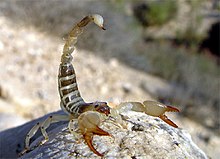
Scorpions are predatory arachnids of the order Scorpiones. They have eight legs and are easily recognized by a pair of grasping pincers and a narrow, segmented tail, often carried in a characteristic forward curve over the back and always ending with a stinger. The evolutionary history of scorpions goes back 435 million years. They mainly live in deserts but have adapted to a wide range of environmental conditions, and can be found on all continents except Antarctica. There are over 2,500 described species, with 22 extant (living) families recognized to date. Their taxonomy is being revised to account for 21st-century genomic studies.

Charybdotoxin (ChTX) is a 37 amino acid neurotoxin from the venom of the scorpion Leiurus quinquestriatus hebraeus (deathstalker) that blocks calcium-activated potassium channels. This blockade causes hyperexcitability of the nervous system. It is a close homologue of agitoxin and both toxins come from Leiurus quinquestriatus hebraeus. It is named after Charybdis, a sea monster from Greek myth.

The emperor scorpion, Pandinus imperator, is a species of scorpion native to rainforests and savannas in West Africa. It is one of the largest scorpions in the world and lives for 6–8 years. Its body is black, but like other scorpions it glows pastel green or blue under ultraviolet light. It is a popular species in the pet trade, and is protected by CITES to prevent over-collecting that might affect the species' survival.

Calciseptine (CaS) is a natural neurotoxin isolated from the black mamba Dendroaspis p. polylepis venom. This toxin consists of 60 amino acids with four disulfide bonds. Calciseptine specifically blocks L-type calcium channels, but not other voltage-dependent Ca2+ channels such as N-type and T-type channels.

Maurotoxin is a peptide toxin from the venom of the Tunisian chactoid scorpion Scorpio maurus palmatus, from which it was first isolated and from which the chemical gets its name. It acts by blocking several types of voltage-gated potassium channel.

Hadogenes troglodytes is a species of scorpion from southern Africa. It is commonly known as the flat rock scorpion and commonly sold on the exotic pet market. It was once regarded as having the longest recorded body length of any scorpion, reaching up to 20 cm; however Heterometrus swammerdami currently holds the record for being the world's largest scorpion at 9 inches (23 cm) in length. May be confused with Hadogenes bicolor.
BmTx3 is a neurotoxin, which is a component of the venom of the scorpion Buthus Martensi Karsch. It blocks A-type potassium channels in the central nervous system and hERG-channels in the heart.
Birtoxin is a neurotoxin from the venom of the South African Spitting scorpion. By changing sodium channel activation, the toxin promotes spontaneous and repetitive firing much like pyrethroid insecticides do
Bestoxin is a neurotoxin from the venom of the South African spitting scorpion Parabuthus transvaalicus. Most likely, it targets sodium channel function, thus promoting spontaneous and repetitive neuronal firing. Following injection into mice, it causes non-lethal writhing behaviour.
BmKAEP is a neurotoxin from the venom of the Manchurian scorpion (Mesobuthus martensii). It is a β-toxin, which shift the activation voltage of sodium channels towards more negative potentials.

Mesobuthus eupeus is a polymorphic scorpion species belonging to the well-known family Buthidae. Commonly known as the lesser Asian scorpion or the mottled scorpion. It is thought to be the most widely dispersed species of the genus Mesobuthus, perhaps even of the family Buthidae.
Phaiodotoxin (PhTx1) is a toxin from the venom of Anuroctonus phaiodactylus, also known as the Mafia scorpion. It affects voltage-gated sodium ion channels leading to an increased duration of its opening.
BeKm-1 is a toxin from the Central Asian scorpion Buthus eupeus. BeKm-1 acts by selectively inhibiting the human Ether-à-go-go Related Gene (hERG) channels, which are voltage gated potassium ion channels.
Hemitoxin (HTX; α-KTx6.15) is a 35-mer basic peptide from the venom of the Iranian scorpion Hemiscorpius lepturus, which reversibly blocks Kv1.1, Kv1.2 and Kv1.3voltage-gated K+ channels.
Tamulotoxin is a venomous neurotoxin from the Indian Red Scorpion.
HsTx1 is a toxin from the venom of the scorpion Heterometrus spinifer. HsTx1 is a very potent inhibitor of the rat Kv1.3 voltage-gated potassium channel.

Leiurus abdullahbayrami is a species of scorpion in the family Buthidae. Its venom is highly toxic to humans, but can be used in medical development.
Humans use scorpions both practically, for medicine, food, and pets, and symbolically, whether as gods, to ward off harm, or to associate a product or business with the evident power of the small but deadly animal.
AsKC11 is a toxin found in the venom of the sea anemone, Anemonia sulcata. This toxin is part of the Kunitz peptide family and has been shown to be an activator of G protein-coupled inwardly-rectifying potassium (GIRK) channels 1/2, involved in the regulation of cellular excitability.

Anuroctonus pococki, also known as the California swollen-stinger scorpion, is a species of scorpion of the family Chactidae. It is native to the coast ranges of Southern California, and into Baja California in North America. This is the only scorpion from the genus Anuroctonus in Baja California. This scorpion, at 65 mm (2.6 in), is large compared to other scorpions found in the region.









